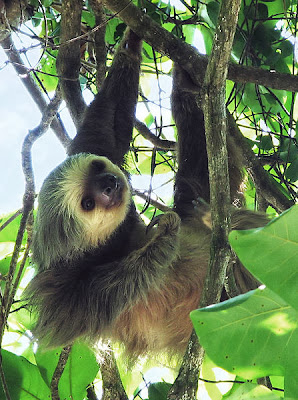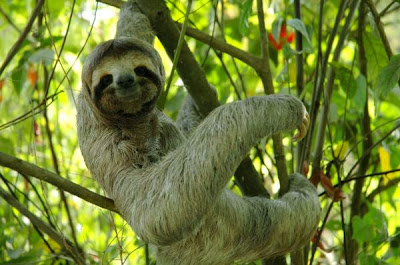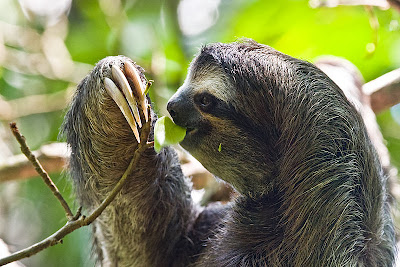 |
| Two-toed Sloth |
Sloths are
medium sized mammals belonging to
the families Megalonychidae (two-toed sloth) and Bradypodidae (three-toed sloth), classified into six species. They are part of the order Pilosa and that’s why related to ant
eaters, which sport a similar set of appropriate
claws. Extant sloths are tree-dwelling
residents of the jungles of Central and South
America, and are known for being slow moving, and on
account of this named "sloths". Extinct sloth species include many ground sloths, some of which come up to the size of elephants.
short time since been
documented eating human faces from open toilets. They have made remarkable adaptations
to an arboreal exploring lifestyle. |
| Three-toed Sloth |
Leaves, their main diet source,
provide very little energy, and do not desolve food easily.Therefore, Sloths, have
large, specific, slow acting stomachs with multiple closets in which symbiotic bacteria break down the troublesome leaves. As
much as two-thirds of a well-fed sloth's body weight consists of the contents
of its stomach, and the digestion process can take a month or more to complete.
Sloths have very low metabolic rates, less than half of that estimated
for a mammal of their size, and maintain low body temperatures when active
(30–34°C or 86–93°F), and still lower temperatures when resting.
 |
| Three-toed Sloth Eating Leaves |
Sloth fur exhibits specific functions: the outer hair grow in a
direction opposite from that of other mammals. Sloths spend so much time with
their legs above their bodies, their hair grow away from the extremities to
provide protection from the elements while the sloth hangs upside down. Sloths
have short, flat heads, big eyes, short snouts, long legs, and tiny ears. Some
species have stubby tails (6–7 cm long). Altogether, sloth’s bodies
usually are between 50 to 60 cm long. Sloth’s
claws serve as their only natural defence. A traped sloth may swipe at its
attackers in an effort to scare them away or wound them. sloths blend in with the trees and, moving only slowly, do not attract
attention. The main predators of sloths are the jaguar, the harpy eagle, and humans. The majority of recorded sloth deaths in Costa
Rica are due to contact with electrical
lines.Sloths move only when
necessary and even then very slowly, While they sometimes sit on top of
branches, they usually eat, sleep, and even give birth hanging from limbs. They
sometimes remain hanging from branches after death. On the ground, the maximum
speed of the three-toed sloth is 2 meter or 6.5 ft per minute.
No comments:
Post a Comment